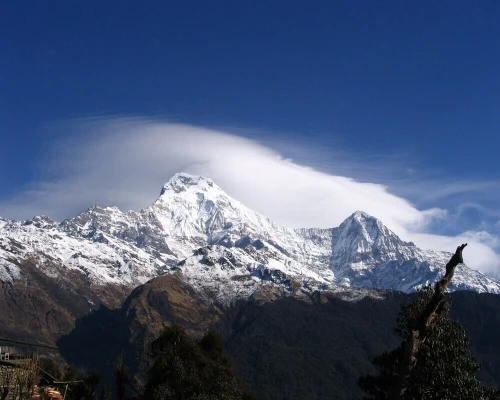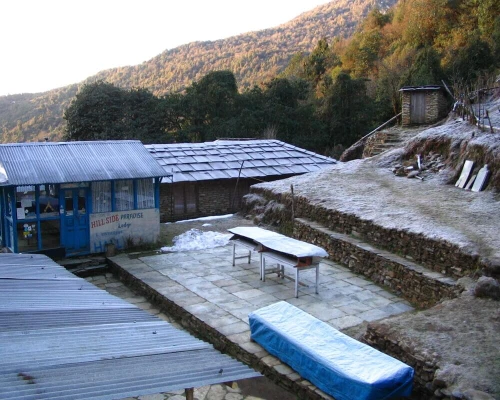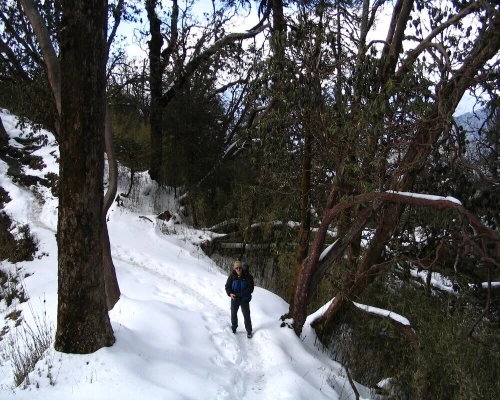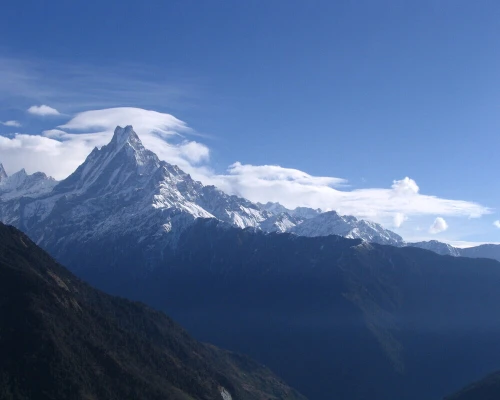Short Annapurna Base Camp Trek is a popular moderate trek that offers a wonderful journey through diverse landscapes and stunning natural beauty. The trek begins amidst lush rhododendron forests, where you'll be surrounded by vibrant blooms during the right season. As you traverse the trekking trails, you'll encounter pristine whitewater rivers and terraced farms, showcasing the harmonious coexistence of nature and human settlements. The trek also presents opportunities to soak in natural hot springs, providing a relaxing respite amidst the rugged terrain. These hot springs offer a soothing experience, rejuvenating your body and mind after days of trekking.
Throughout the trek, you'll have the chance to visit ethnic Gurung villages, immersing yourself in the local culture and way of life. The Gurung people are renowned for their warm hospitality and rich traditions, offering you a glimpse into their unique heritage.
One of the main highlights of the trek is reaching the Short Annapurna Base Camp for 2025-2026, situated at an elevation of 4130 meters. As you make your way to this iconic destination, you'll be rewarded with awe-inspiring views of snow-capped peaks. The Annapurna ranges, including the majestic Annapurna I, Machhapuchre (also known as Fishtail), Khangsar, Gangapurna, and Hiunchuli, grace the horizon, creating a truly mesmerizing sight.
The trek to Annapurna Base Camp is not only a physical adventure but also a spiritual and visual feast. It allows you to immerse yourself in nature's grandeur, witness the cultural tapestry of the local communities, and challenge yourself in a moderate yet rewarding trekking experience.
- Flying to Pokhara offers an incredible opportunity to enjoy the scenic beauty of the surrounding landscapes. As you gaze out of the windows, you'll be treated to breathtaking vistas that will leave you in awe. The journey itself becomes a part of the adventure, as you witness the majestic mountains and lush valleys unfold beneath you.
- Once you arrive in Pokhara, you'll have the chance to explore the Annapurna Conservation Area, which is the largest conservation area in Nepal. This pristine region is home to a diverse range of flora, including vibrant Rhododendron flowers, fragrant juniper trees, majestic pine trees, and the graceful swaying of bamboo. The conservation area is a testament to Nepal's commitment to preserving its natural treasures.
- One of the highlights of your journey will be crossing the Kali Gandaki Gorge, which is renowned as the deepest gorge in the world. As you pass through this awe-inspiring natural wonder, you'll witness the sheer power of nature and the forces that have shaped the landscape over millions of years.
- Engaging with the local villagers will be a memorable experience, as most of them belong to the Gurung, Tamang, and Magar communities. These warm and welcoming people will introduce you to their rich cultural heritage, allowing you to immerse yourself in the traditions, customs, and daily lives of the local communities. You'll gain insights into both Hindu and Buddhist traditions, as Nepal is a country where these two religions coexist harmoniously.
- Visiting ancient Buddhist monasteries will be a spiritual and visually captivating experience. These monasteries, adorned with beautiful prayer flags fluttering in the wind, provide a serene and contemplative atmosphere. They offer a glimpse into the profound spiritual practices and teachings of Buddhism, while their picturesque locations present awe-inspiring views of the surrounding mountains.
- One of the highlights of your journey will undoubtedly be the Poon Hill viewpoint. From this vantage point, you'll be treated to jaw-dropping panoramas of the majestic Dhaulagiri and Annapurna mountain ranges, among others. The sight of these towering peaks, bathed in the golden hues of sunrise or sunset, is a sight that will forever be etched in your memory.
- After days of exploration and adventure, you'll have the opportunity to relax and rejuvenate in the natural hot springs of Jhinu Danda. These soothing waters provide the perfect respite, allowing you to let go of any accumulated stress and fatigue. The surrounding scenery further enhances the experience, as you immerse yourself in nature's healing embrace.
- Lastly, standing at an elevation of 4130 meters with your team members is a remarkable accomplishment. Celebrating this achievement amidst the awe-inspiring presence of the mountains will be a truly unforgettable moment. The sense of camaraderie and shared accomplishment will create lasting memories and deepen your appreciation for the beauty and grandeur of the natural world.
- Overall, the journey to Pokhara and the Annapurna Conservation Area offers a perfect blend of natural beauty, cultural immersion, and personal growth. It is an adventure that will leave you with a profound appreciation for the wonders of Nepal and its people, as well as a renewed sense of wonder and connection to the natural world.
Shortest Trek to the Annapurna Base Camp
It is a shorter version of the 9-day Short Annapurna Base Camp Trek, making it suitable for those who have limited time but still want to enjoy the trek. The trek starts at Kimche, which is a two-hour drive from Pokhara. From there, you will follow a trail that takes you through dense rhododendron and bamboo forests, stunning terraced fields, and suspension bridges to reach the traditional Gurung village of Ghandruk, which serves as the destination for the first day.
As you continue on the trek, you will walk through lush forests, grass pastures, rocky passes, and cliffs until you reach Chomrong. Along the way, you will be treated to magnificent views of the Annapurna massifs and Machhapuchre (fishtail) mountain.
Leaving Chomrong, the path gradually ascends through more rhododendron and bamboo forests, leading you to the Himalayan Hotel. On the sixth day, you will reach Annapurna Base Camp at an altitude of 4,130m (13,550ft), passing Machhapuchre Base Camp along the way. The trail follows the Modi Khola glacier valley, offering panoramic views of Hiunchuli, Annapurna ranges (including Annapurna I), Khangsar Kang, Gangapurna, and Macchapuchre. You will spend a night at Annapurna Base Camp itself.
After a night at the base camp, the descent begins and you will stop at Bamboo on the seventh day. The following day, you will trek from Bamboo to Jhinu Danda, where you can relax in the natural hot springs nearby. On the last day of the trek, you will trek from Jhinu Danda to Siwa or Ghandruk Phedi, and from there, you will take a drive to Pokhara, concluding the trip.
At the end of the trek, Nepal Nomad Trekking, the hosting company, organizes a farewell dinner in Kathmandu to celebrate the completion of the trek. Overall, the Annapurna Base Camp trek offers a mix of natural beauty, cultural experiences in ethnic Nepalese villages, and stunning mountain views, making it a memorable adventure for those with limited time.
Best Time of the year
Short Annapurna Base Camp Trek is accessible throughout the year, but the best time to embark on the trek is between March and May or September and November. These months offer favorable weather conditions and enhance your overall hiking experience.
It is not recommended to trek during the monsoon (June to August) or winter (December to February) seasons due to heavy rainfall, snowfall, and the associated risks. Hiking during these seasons can lead to injuries and potential natural calamities. To ensure a safe and enjoyable trek, it is advisable to choose the best time for the Annapurna Base Camp Trek.
Moderately Difficult Level Trek
The Short Annapurna Base Camp Trek is considered a moderate trek in terms of difficulty. The trek involves hiking on uphill and downhill terrains with relatively steep sections. You will be walking for approximately 5-6 hours each day with regular breaks. However, with adequate rest and taking in the breathtaking scenery, the trek can be easily completed.
In terms of elevation, the highest point you will reach is 4,130 meters at the Short Annapurna Base Camp. While hiking at this altitude, there is a lower chance of experiencing altitude sickness. The trek itinerary is designed to allow for proper acclimatization, giving your body time to adjust to the altitude.
Overall, the Short Annapurna Base Camp Trek is suitable for beginner hikers as well. With the right preparation, including physical fitness and acclimatization, most individuals can successfully complete this trek.






